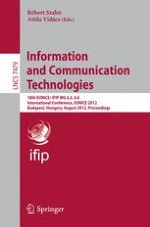2012 | Buch
Information and Communication Technologies
18th EUNICE/ IFIP WG 6.2, 6.6 International Conference, EUNICE 2012, Budapest, Hungary, August 29-31, 2012. Proceedings
herausgegeben von: Róbert Szabó, Attila Vidács
Verlag: Springer Berlin Heidelberg
Buchreihe : Lecture Notes in Computer Science
